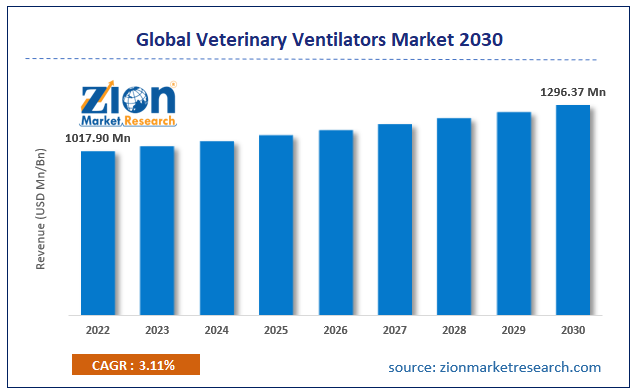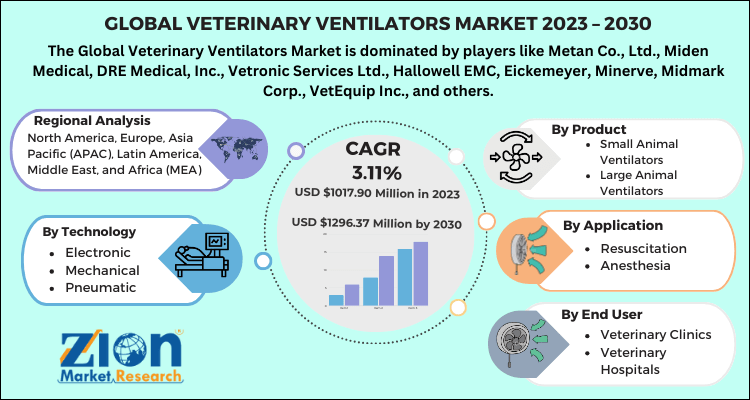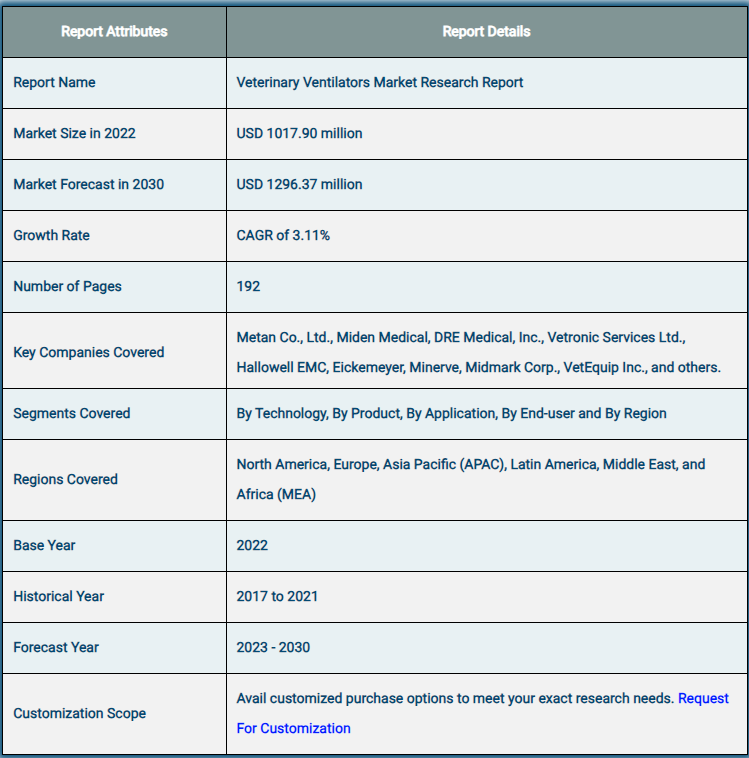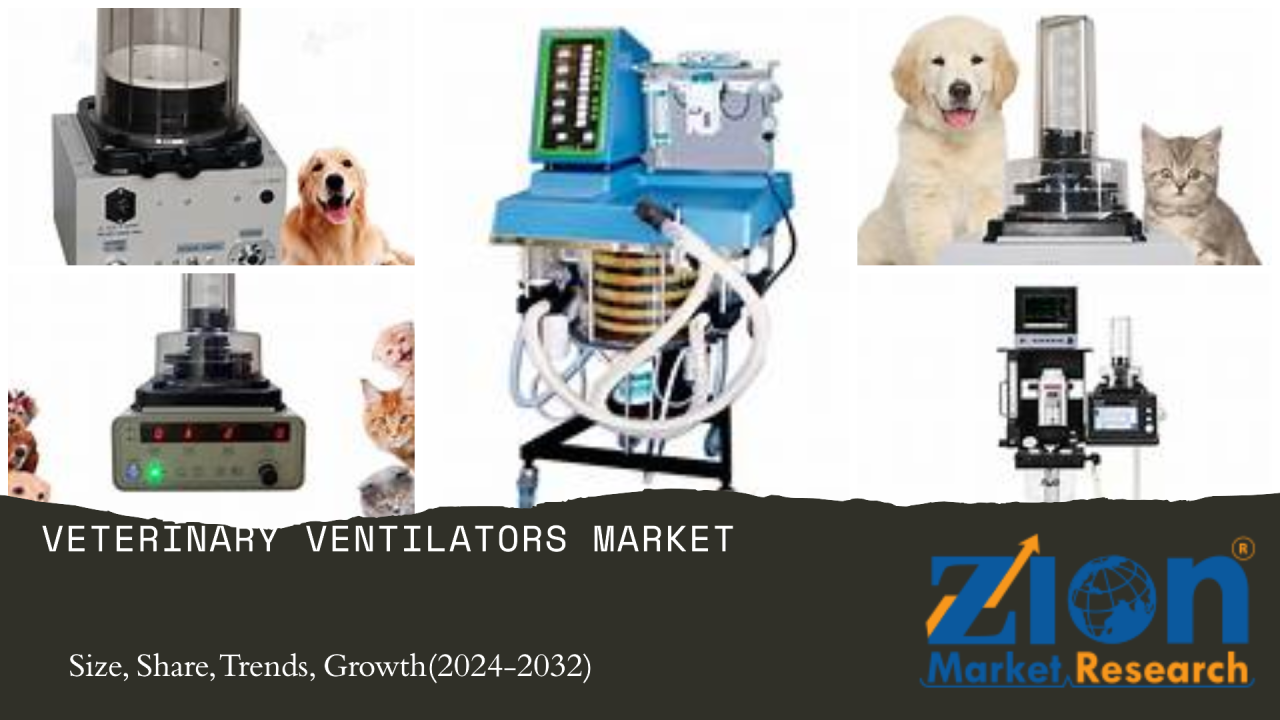The global veterinary ventilator market is expected to grow from its estimated USD 1017.90 million in 2024 to USD 1296.37 million by the end of 2032, according to a report released by Zion Market Research. Over the course of the projection period, the market is anticipated to expand at a CAGR of 3.11%. The study examines the factors that will propel, impede, and affect demand for veterinary ventilators globally throughout the course of the projection period. Additionally, it will support you in navigating and investigating the new opportunities in the veterinary ventilator sector.
Abstract:
The veterinary ventilators market is a crucial segment within the broader veterinary medical devices industry, driven by the increasing need for advanced respiratory support for animals. This research article provides a comprehensive analysis of the veterinary ventilators market, highlighting key trends, technological advancements, market dynamics, and future growth opportunities. It offers valuable insights for manufacturers, healthcare providers, and industry stakeholders.
Introduction:
Veterinary ventilators are essential for providing respiratory support to animals in critical conditions, including those undergoing surgery, trauma, or respiratory diseases. This article examines the current state of the veterinary ventilators market, focusing on emerging trends, technological innovations, and potential growth areas. It also addresses the challenges and opportunities facing the industry.
 Veterinary Ventilators Market
Veterinary Ventilators Market
Overview of the Global Veterinary Ventilators Market
Veterinary ventilators are essential to animal therapies and treatments because they help animals that cannot sustain their own ventilation. These ventilators maintain the animal’s ability to breathe, giving the veterinarians more time to address the condition. Veterinary ventilators are needed in a number of circumstances, such as envenomation, medication toxicity, pneumonia, congestive heart failure, paralysis from tick bites, and various surgical procedures. Numerous ventilator kinds are available that may be utilised for both small and large animals. They come with technological features including mechanical, pneumatic, electrical, and electro-pneumatic functions that can be used for anaesthesia and resuscitation.
Market segmentation for veterinary ventilators worldwide
The veterinary ventilator market is divided into segments based on technology, product, application, and end-user around the globe. The worldwide market is divided into electronic, electro-pneumatic, mechanical, and pneumatic segments based on technology. The market is divided into two segments based on the kind of product: small animal ventilators and large animal ventilators. The market is separated into resuscitation and anaesthesia segments based on the application. The market is divided into veterinary hospitals and clinics based on the final user.
 Veterinary Ventilators Market
Veterinary Ventilators Market
Growth Factors for the Global Veterinary Ventilators Market
The growing number of non-governmental organisations (NGOs) devoted to pet care and the rising need for veterinary equipment are the main drivers of the market’s expansion. Ventilators are more in demand at animal treatment facilities since there is a higher chance that anesthesia-related issues would arise during an animal’s treatment. The market for veterinary ventilators is being positively impacted by a variety of other factors, including an increase in veterinary care, technical improvements, and the number of clinics and doctors. The expansion of the business can also be attributed to the insurance offered to pets. The market is growing, but it is only growing because certain instruments are not available in developing nations and because capital requirements are high.
Market Scope for Veterinary Ventilators: Report
 Veterinary Ventilators Market
Veterinary Ventilators Market
Regional Analysis of the Global Veterinary Ventilators Market
The veterinary ventilator market is divided into the following regions: North America, Latin America, Asia Pacific, Eastern and Western Europe, Middle East & Africa, and North America. North America and Europe are the two well-established markets for veterinary ventilators. The main participants in the industry and the existence of reputable veterinary clinics and hospitals are the main causes of this dominance. Another element that supports the industry is the notable rise in companion animal populations in these areas. Latin America is the area of the veterinary ventilator market that is expanding the fastest. The Asia Pacific region’s high cattle population necessitates the use of veterinary ventilators.
Key Trends:
- Technological Advancements:
- Integration with Telemedicine:
- Customization and Adaptability:
- Focus on Safety and Efficiency:
Technological Innovations:
- Advanced Monitoring Systems:
- Improved Ventilation Modes:
- Enhanced Portability:
Challenges and Barriers:
- Cost and Accessibility:
- Regulatory and Compliance Issues:
- Training and Expertise:
Future Opportunities:
- Market Expansion:
- Innovation and R&D:
- Enhanced Veterinary Care:
Conclusion:
The veterinary ventilators market is poised for significant growth, driven by technological advancements, increasing demand for advanced veterinary care, and the rising prevalence of respiratory conditions in animals. While challenges related to cost, regulation, and training persist, the market offers substantial opportunities for innovation and expansion. Stakeholders must stay informed about emerging trends and technological developments to leverage the full potential of the veterinary ventilators market.
Contact Us:
Zion Market Research212
USA/Canada Toll Free: 1 (855) 465–4651
Newark: 1 (302) 444–016611\s
Web: https://www.zionmarketresearch.com/
Blog: https://zmrblog.com/
